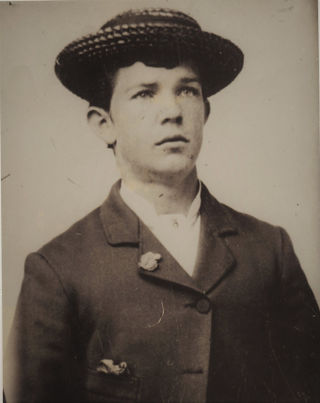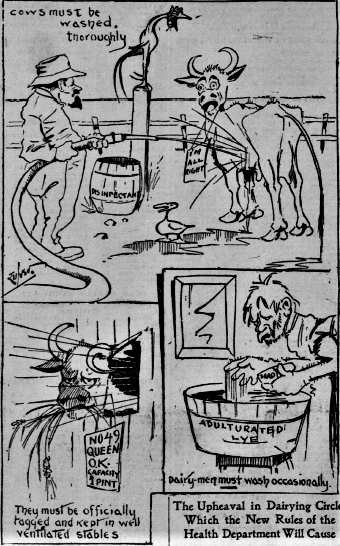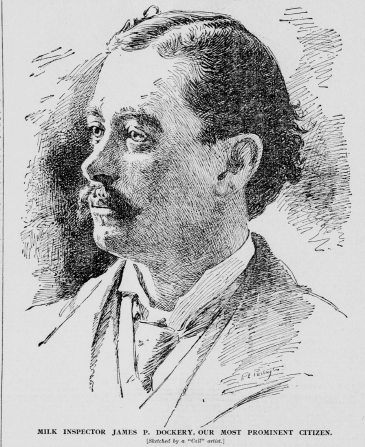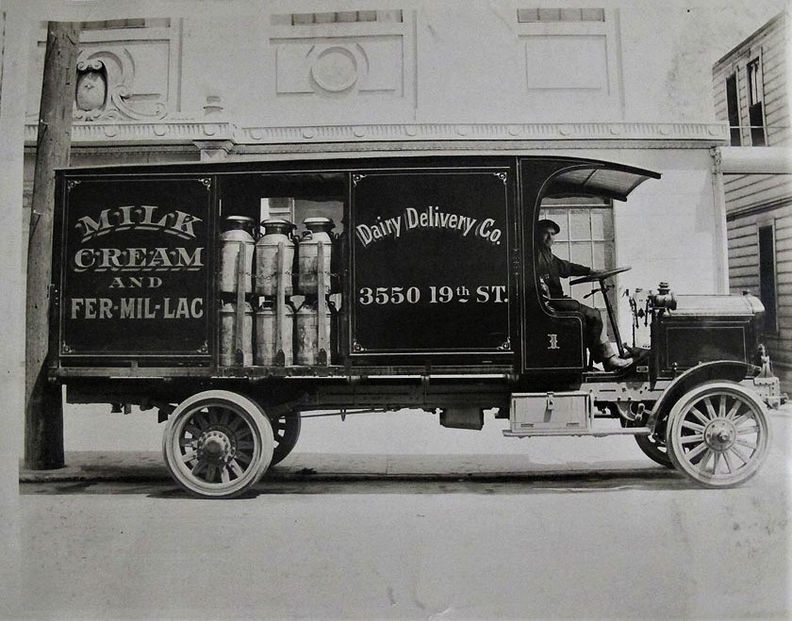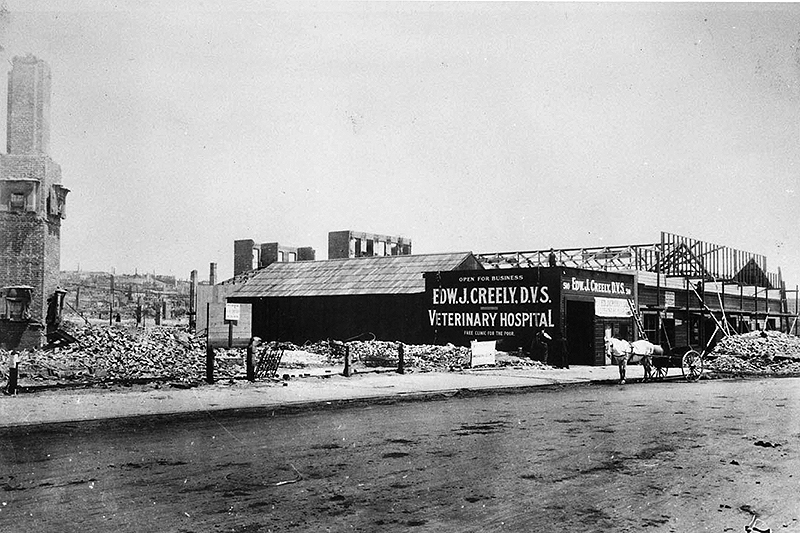Cattle Raids of Creely
Historical Essay
by Elizabeth Creely
Originally published as part one of "Edward J. Creely and the Changing City: 1870-1920"
Edward J. Creely, looking pious. This is a tintype taken on August 4th, 1884 at Vans Department store, 111 4th Street in San Francisco.
Courtesy Elizabeth Creely
“The key to the understanding of Ireland—Irish history, Irish archaeology, Irish culture, the great sagas—everything is based on cattle. Cows are everything and everywhere.“ —Dr Patrick Wallace, director of the National Museum of Ireland
One hundred and twenty-four years ago, on a cold December morning in 1894, Edward Creely, San Francisco’s veterinary surgeon, and his colleague James P. Dockery, the city’s newly appointed Milk Inspector, drove to Butchertown, on the outskirts of San Francisco. Once there, the men changed into working garb, holstered their guns, and walked into the mudflats of Islais Creek. Creely and Dockery were preparing to go on a cattle raid.
In the early eighteen-nineties, the year Edward Creely’s story begins, the sight of a cow was commonplace, and encouraged San Franciscans to believe that there was fresh milk to be had. There was, if you owned a cow, or lived near one of the sprawling 1000-acre dairies in the Excelsior Homestead or the Sunnyside district. But most people didn’t.
Unscrupulous dairy owners knew that there were customers to be had, and sold them milk from cows afflicted with tuberculosis, and laced with formalin, or hydrogen peroxide. To increase the volume of milk, and their bottom line, the dairies diluted the milk with water contaminated with fecal matter, a practice described by a dairyman in an 1894 San Francisco Chronicle article about a new proposal before the board of supervisors: a dairy inspection ordinance.
“Cows must be washed thoroughly”, a cartoon from the San Francisco Call, Oct. 22, 1896
“I have seen some of these milk mixers dip up water from a trough where horses drink and put it in the milk. At many of these cheap dairies the seepage from the barnyard has a deleterious effect on the water used for dilution.”
The free-range cows of San Francisco, eating and shitting freely, led to an even wider-ranging community of Vibrio cholerae, the bacteria that causes cholera. Dairymen like John Linehan, whose daughter Julia married Edward’s brother Thomas, milked the public of their money as readily as the early merchants of San Francisco mined the miners. Edward, my great-granduncle, lived a pretty good life as a prosperous and renowned veterinary surgeon. But he hit a couple low points along the way, mostly because of cows and their white milk. Both were his bete noir.
“… a city is apt in the plenitude of its sanitary advantages, to pass through its early stages of growth and to develop into a metropolis before it awakens to a recognition of the truth that this heritage is exhaustible. ..ultimately it must throw around them the protective agencies of modern sanitary science.”
A.S. Lovelace, health officer for the Board of Public Health in San Francisco made this sober observation in 1896, after the first year of dairy inspections. It was likely the text version of an argument he’d made in city chambers trying to convince reluctant supervisors to spend money safeguarding public health. Lovelace must have known that the protective agency of “modern sanitary science” would be met with defensive indignation from industries that didn’t want, then as now, to be regulated.
The city’s first milk ordinance was introduced in 1893 by George Knight, attorney to the Board of Health. Smaller dairy owners opposed regulation, knowing that the cost of cleanliness would put them out of business. (San Francisco, then as now, has always been steadfastly agnostic when grappling with the decision to regulate disruptive entrepreneurs.) Their stalling worked, for a time. The ordinance didn’t pass until 1896. But change was in the air. The standards proposed in 1893 provided a roadmap to a better, more hygienic future. Milk couldn’t contain less than 12 ½ percent of milk solids, among other things, and dairy owners couldn’t keep sick cows. But how was the city to keep track of the milk flowing from the thousands of cows ranged over 49 square miles?
James Patrick Dockery, 1864-1913, San Francisco’s first Milk Inspector.
What was needed was a city official who could perform inspections, enforce regulations, and keep wily dairy owners in check. In September of 1895, the city mustered the will to hire James P. Dockery, an energetic Irish-American, as San Francisco’s first ever Milk Inspector.* “He Will Destroy All Impure Milk,” promised the San Francisco Chronicle.
A mixture of virtue and outrage drove Dockery, a restaurateur who had experience dealing with crooked milkmen, who often paid thousands of dollars to secure the business of restaurant owners. They recovered their investment by selling the same restaurant adulterated milk. Dockery declared war on the dairies, declaring that they had “murdered infants” and could be tolerated no more.
He wasn’t wrong. Unsanitary milk was an inconvenience the city had learned to live with, along with deaths from infectious diseases. More than 20,000 San Franciscans died of “zymotic” or infectious diseases since the Board of Public Health started keeping records in 1871.
Dealing with the dairies was humane, but pragmatic, too. It’s tough to build a city if a significant percentage of the population is constantly wracked by acute digestive disorders. Playtime was over for San Francisco. If city residents wanted more than protection from fires and vigilance mobs, the frantic relationship between consumer and producer—I got what you want/you’ve got what I need–had to be intervened with, and a new approach to the city’s future mapped out.
That new approach, a reformist political movement termed Progressivism, played out in cities across the nation. The drive for hygienic dairies, and the concern for public health, signaled a sustained challenge to inefficient, corrupt “pay to play” politics and marked the onset of centralized city government, a strong mayor and a preference for regulation of industries. Pure milk could serve as proof that the city had shrugged off the florid uncleanliness of the Gilded Age that produced men like Chris Buckley, the Irish-born “Blind Boss” who ran San Francisco during the eighteen eighties and early eighteen nineties.
Cracking down on filthy dairies meant drafting municipal codes, antagonizing unscrupulous dairy owners, lobbying reluctant city supervisors and clashing with other men, equally intent on reforming San Francisco’s lackadaisical approach to public health. City Hall was a dumping ground for male ambition, and everyone sloshed around in it, including Dockery and Creely.
The city’s meat inspector, a man named Ben Davis, complained that Dockery’s vigilance was usurping his role as the meat health inspector. Creely, a political appointee who became the city’s veterinary surgeon in 1883, was charged with graft by “Doc” Burns, the former City Veterinarian who was replaced by my great uncle. None of this slowed Dockery or Creely down. It was a heady time in city government, a moment to stand in stark contrast to other, more inferior men. Men possessed of ambition and civic virtue (real or imagined) could hitch their wagons to the rising tide of reform, and gain a lifetime of public approbation.
J. Tomkinson Livery and Stable located at 57, 59 and 61 Minna street, circa 1871. The boarding house at 55 Minna street is directly to the left of the stable.
Image from the California State Library
In the beginning, Edward Creely was a part of the solution, not the problem. He was born in Stockton in 1867, the first son of James and Margaret McCarty Creely. His father, a farrier by trade, moved the family from Stockton to 55 Minna Street, Ward 11, in the South of Market in 1870. The family dwelling sat next to the J.Tompkinson Livery, a stable that spread over two city blocks, making the densely populated neighborhood a forerunner to today’s transit village.
Edward grew up in his father’s horseshoeing shop on Mission street. James Creely managed to corner a vital piece of the horseshoeing market: according to my grandfather, he shod the horses owned by the city and county of San Francisco. The Creely forge was a hangout for city politicos, major and minor. Edward grew up listening to the political chatter of the adults as he fired the forge and helped control the restive bodies of horses as shoes were hammered onto their hooves.
When Edward was six, his father moved the family to the outskirts of Butchertown, a famously disgusting place, and began working for Zhan and Langermann, blacksmiths and wagon-makers. Butchertown, which roughly corresponds with the industrial area east of Bayshore and south of Cesar Chavez, was founded in 1868 by butchers after they were forbidden by the city from slaughtering animals inside city limits. They bought 81 acres of land from the State, and carried on until 1971 as the city’s abattoir, aided by Islais Creek and the bay which formed a natural dumping grounds for the blood and guts issuing from the slaughterhouses.
The Creelys lived on Railroad Avenue, a street platted on a narrow spit of land surrounded by mudflats. The smells and sounds of the animals on their way to slaughter must have been wretched: I can’t imagine how my great-great grandmother felt about living with four children in such noisome and sanguine isolation. (Or maybe I can. The family moved back to the South of Market within the year.)
Twenty years later, Edward Creely was back in Butchertown helping conduct Dockery’s war on toxic milk, which was well underway. Dockery began that fall by stopping dairy wagons on their way into the city. Brandishing his “lactometer” (you can purchase one for 9.99 on Amazon) he tested the milk on the spot, usually on the side of Mission road or San Bruno avenue and dumped the entire contents of the wagon if the milk failed the Babcock test, named after the 19th-century chemist who devised the test to determine levels of butter fat and adulterants.
In his first month on the job, Dockery stopped 450 wagons, and boasted of dumping 2,000 gallons of milk, usually around midnight, and almost always over the heated protests of the milkmen. After dumping 25 milk cans from John Linehan’s Green Valley dairy** and being threatened by Linehan and his sons, Dockery made his intentions clear: “… I want it distinctly understood that so long as I am Milk Inspector, I will dump every can of milk not up to the standard prescribed by the Board of Health. I will do this if I have to hold a gun in one hand while I empty the cans with the other.”
The press, impressed with Dockery’s alacrity and mindful of the affront to the local dairy industry, called these inspections “raids” which was fitting. Both Creely and Dockery’s Irish roots lay in places famed for cattle raiding, Ulster and Connacht respectively, which is where the legendary Irish epic the Tain Bo Cuilgnne (the Cattle Raid of Cooley) took place. In the winter of 1895 and the spring of the following year, readers of San Francisco newspapers were treated to a local version of the Tain, minus a queen named Mebh, as Dockery and Creely raided dairies, impounded—and occasionally shot—tubercular cattle and skirmished with resentful milkmen in the green hills and wetlands of San Francisco.
Dockery and Creely were in Butchertown to stop dairymen from grazing their cattle on swamp grasses and pickleweed. Grazing livestock in wetlands isn’t unusual, as in France, where agneau de pré-salé—lamb grazed in salt marshes—is a delicacy. But salty milk that tastes like shit has never been popular. The cow’s fodder was liberally laced with human feces, a carrier of Salmonella enterica,a result of the five city sewers that emptied their contents into the marshes of Islais Creek. The dairymen who gazed their cattle there did so because they couldn’t afford (or didn’t want to purchase) quality feed.
Ambition drove Edward into the marsh to chase cows in 51-degree weather. He was a young man, with a growing family and a newly opened veterinary hospital grandly named the New York Veterinary Hospital, located at 510 Golden Gate avenue, around the corner from his uncle John McCarty, who was also a farrier.
Edward, and his younger brother James and Tom were college-educated (the Creely sisters were not) and busy men with work that tended more and more to the white collar world. In 1893, Edward became a weekly columnist for the Pacific Rural Press, an agricultural newspaper printed in San Francisco, and began dispensing medical advice to livestock owners in Northern California who needed his help solving the problems of the grubby, frequently gruesome world of animal husbandry. Chasing cows was all in a day’s work. But it was nasty work. Decomposition is the way of life in a wetland, but the process, which makes short work of a strand of eel grass, isn’t equal to the task of breaking down the body of a dead horse, a sight that greeted Dockery and Creely that morning.
Going to Butchertown was Dockery’s idea. There had been an outbreak of typhoid in Oakland and San Francisco, which prompted the Milk Inspector to crack down on the “Italian swamp ranch community” who were known to pasture their cows in the marsh, near the Golden City homestead at Tulare and Illinois Streets. Dockery’s plan was simple. He was going to drive the cows to the pound, about two miles away and arrest anyone who tried to claim them.
Accordingly, the men began their muddy cattle raid by shooing the cattle west toward San Bruno Road. This provoked an immediate response from the owners of the livestock who emerged half-naked from the depths of the muddy swamp—“most of them had very little wearing apparel on,” the paper noted disapprovingly– and rushed Dockery and Creely, with sticks and dogs. The milk inspector and the surgeon fended off enraged dairymen by firing shots in the air, which drove the men and most of the cows away. The Mission police were summoned and the remainder of the herd taken to the pound. Two hours later, dairymen Alessandro Di Sante, Edwino Del Sante, and Bartholomew Mozetti were charged with a misdemeanor and taken to the 17th street police station. (Dockery later bailed Del Sante out of prison to the relief of his children and weeping wife.)
All in a day’s work and yet the loss of a cow, no matter how sickly, has never been a small matter. The Pacific Rural Press reported that a good Holstein calf could cost around about $500, about $4,000 adjusted for inflation. In the same San Francisco Chronicle article about the proposal to inspect dairies, an unnamed dairyman noted that good milk cost good money and cited the Guadaloupe Dairy, located on Valencia Street, as an example, stating that they invested about $150,000—more than 4 million—annually in their operations. The shirtless men pasturing their cows along the creek may have owned their cows, but maybe not much else, certainly nothing resembling a dairy. Fodder and water could be free if you weren’t too picky, but infrastructure was for the rich.
“Inspector Dockery interviews Mrs. O’Brien”, San Francisco Examiner, San Francisco Chronicle, Dec. 10, 1895. Uncle Edward and Bessie the cow look on.
Still, a sickly cow had some value. This was the case with a cow named Bessie who had been caught up in the December raid. She was claimed by her owner, Mrs. O’Brien, who explained that Bessie’s lacteal fluid nourished her and her four children. It might have infected them too. The cow had been declared consumptive by Dockery. But in Mrs.O’Brien’s view, milk from a tubercular cow was better than nothing. Dockery released the cow into Mrs. O’Brien’s custody, an act of graciousness that “took by storm the affections of the people of Ireland,” according to the San Francisco Chronicle.
It was an easy gesture to make. Bessie was doomed. Destined to give what milk she could with the feed available to her, probably far less than two gallons a day, she was likely slaughtered in Butchertown when her milk ran out, and dumped into the bay to be washed back into the marsh by the tides. Her flesh and the flesh of other cows littered the landscape, like the brawling bulls of the Tain Bo Cuilgne, but unlike those mythic beasts, their bodies had no value and didn’t name that awful landscape.
Dockery wrote a report for the 1895-96 San Francisco Municipal Report detailing the results of his busy year. Out of 3,784 cows inspected, 36 were killed. More than 7 thousand gallons of milk was dumped and 228 warrants for arrest issued.
The same year, infectious diseases killed 472 people, mostly infants in the 11th ward, the first place my family lived in San Francisco. To be a baby in the 11th ward, or a cow in the Islais swamp was to share a common fate: illness and death due to disease spread by San Francisco’s commercial dairies. It would be another decade before the dairy industry was brought to heel.
“Milk Drugged With Hair Dye Poisons A Baby Victim”. San Francisco Call, October 1905.
Milk and dairy inspection lagged during the Schmitz mayoralty. This was how it came to be that in October 1905, Gladys May Tumalty, Edith Hays, and Ruth and Francis Lent, all infants and toddlers, drank milk containing formalin and hydrogen peroxide that came from the dairies of two of the city’s worst offenders, George C. Smart, owner of the New York Dairy and John Linehan, owner of the Green Valley Dairy. Formalin was used to retard spoilage and hydrogen peroxide was a folk remedy thought to kill Mycobacterium bovis, the bacteria that causes bovine tuberculosis. (It didn’t.)
Smart was smart. After paying a fine of $200 dollars, and narrowly avoiding a jail sentence, he launched the Dairy Delivery Company with John Daly and other dairy owners. They published a pamphlet in 1906, the year the Pure Food and Drug Act was passed. It’s a masterpiece of re-branding. “Every operation is conducted on strict sanitary principles,” the company claims. The pamphlet shows clean rooms full of sparkling machinery, and not a single cow in sight.
Picture of the Dairy Delivery Company, sometime after 1906. The Mission District address, 3550 19th is clearly visible on the truck.
Image courtesy of Glenn Koch
In 1912, the Board of Supervisors passed city ordinance 2329 which set the standards for pasteurized milk. That year, just four children under one year of age died of cholera in San Francisco.
“To each cow, its calf,” said the High King of Ireland, Diarmait mac Cerbaill, in his famous 6th-century anti-copyright ruling, meaning all rights revert to the owner. mac Cerbaill’s ruling is about restoration, and so, too, is the idea that undergirds public health, which has always been both desperately needed and a hard sell. Disease and illness carry more than bacteria: they carry stigma, too, a suspicion that people are sick because of some moral failing. This is why oral hygiene is not covered by public health care plans, incredible as it may seem. You could have flossed more, the thinking goes. Perhaps someone thought you could have paid more for your milk, as they read about Gladys May Tumalty, the infant poisoned by hydrogen peroxide. It’s an old problem, this ambivalence about what we owe one another. But from time to time, it’s been settled as a question.
San Francisco legislators, faced with the “necessity of sanitary reform”, made it clear in their ordinances that a defining characteristic of what it meant to be a San Franciscan, beyond the accident of birth, was having access to untainted milk and later, inexpensive public transportation and a water supply that’s one of the best in the country. To each San Franciscan, their health: this ruling is lettered nowhere within city limits, but its spirit remains in the mission statement of the San Francisco Department of Public Health. The mission of the San Francisco Department of Public Health is to protect and promote the health of all San Franciscans.
It’s a tall order. But as long as we live together, linked by the fluidity of water, grounded by the turbulent earth, and impacted by rapidly destabilizing climate, it will always be a better approach, this idea that by considering ourselves as part of a greater whole, we stand a chance of surviving.
Creely veterinarian hospital, c. 1906.
Photo: provenance unknown
(*) How much the city paid Dockery is unclear. The municipal report for fiscal year 1895-96 notes his position as Milk Inspector, but doesn’t list a salary. In a San Francisco Chronicle article, Dockery claims that a state law empowers him; however, according to state librarian Angelica Illuca, the first state law that appears to directly reference Dairy Inspections is dated 1899. So, I don’t know. Was he a freelance milk inspector? In a San Francisco Call article dated November 1st 1895, it is noted that William Broderick, the city auditor, has allowed JP Dockery’s “first salary warrant, in spite of all the talk to the contrary“. The city did pay him, but how much and under what conditions is, as of this writing, unclear to me.
(**) A digression (sorry!) John F. Linehan, 1841-1915, and his father, also named John, were major players in the dairy dynasties of San Francisco. The senior Linehan’s dairy was located at Laguna and Greenwich in Cow Hollow. After the city insisted that dairies remove themselves for hygienic reasons, the Linehan family opened the Green Valley Dairy in the Excelsior Homestead near Vienna and France streets. This move did not make them more hygienic, by the way. Delightfully, the Linehan family hailed from a town named Boherbue in County Cork, Ireland. “Bo” is the Irish word for cow, and the term “Bóthar” means cattle road. This is both utterly (udderly?) coincidental, and totally not.
With love and thanks to all who helped out with this piece, including Amy O’Hair, historian for the Sunnyside neighborhood, the lovely Glenn Koch for his help sourcing images of San Francisco’s dairies, Angelica Illuca, librarian at the Witkin State Law Library, Frances Kaplan, librarian at the California Historical Society, the Western Neighborhoods Project, whose podcast episode 289 is a must listen, the San Francisco Department of Memory, and Tarin Towers and Elyse Shafarman who have been very good to me throughout this process.

